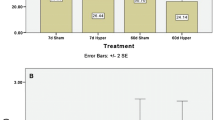Abstract
We examined the effects of bromocriptine on the ultrastructure and on the levelsof messenger RNA (mRNA) of prolactin and growth hormone (GH) in a cultured GH3 cell line. Prolactin and GH concentrations measured by radioimmunoassay in the incubation medium as well as the cell number of the GH3 cells were significantly decreased by treatment with 10-4M bromocriptine for 24 hours. Electron microscopy of bromocriptine—treated GH3 cells demonstrated accumulation of cytoplasmic vacuoles containing cytoplasmic components including secretory granules (crinophagy) which were positive for acid phosphatase staining. The remarkable morphological changes in GH3 cells, induced by treatment with 10-4M bromocriptine for 24 hours, disappeared 48 hours after substitution with bromocriptine-free medium. An immunoelectron-microscopic study demonstrated gold particles binding with antiprolactin antibodies not only In the cytoplasm but also inside vacuoles of GH3 cells after incubation with bromocriptine for 24 hours. Treatment with 10-4M bromocriptine for 24 hours caused the reduction both of mRNAs of prolactin measured by dot-blot hybridization and the Northern-blotting method and of GH measured by the Northern-blotting method. In conclusion, bromocriptine induces a reversible lysosomal change and could inhibit gene transcription of prolactin and GH in GH3 cells.Endocr Pathol 4:28–33, 1993.
Similar content being viewed by others
References
Cronin MJ, Faure N, Martial JA, Weiner RI. Absence of high affinity dopamine receptors in GH3 cell: a prolactin-secreting clone resistant to the inhibitory action of dopamine. Endocrinology 106:718–723, 1980.
Davis JRE, Sheppard MC, Heath DA. Giant invasive prolactinoma: a case report and review of nine further cases. Q J Med, New Series 74. 275:227–238, 1990.
De Marco L, Mashiter K, Caughey B, Peters TJ. Effect of bromocriptine on pituitary organelle marker enzyme activities in lactating and postlactating rats: selective activation of lysosomal prolactin proteolytic activity. Endocrinology 115:984–989, 1984.
Duffy AE, Asa SL, Kovacs K. Effect of bromocriptine on secretion and morphology ot human prolactin cell adenomas in vitro. Horm Res 30:32–38, 1988.
Faure N, Cronin NJ, Martial JA, Weiner RI. Decreased responsiveness of GH3 cells to the dopamincrgic inhibition of prolactin. Endocrinology 107:1022–1026, 1980.
Johnston JM, Wood DF, Bolaji EA, Johnston DG. The dopamine D2 receptor is expressed in GH3 cells. J Mol Endocrinol 7:131–136, 1991.
Kamijo K, Sato M, Saito T, Yachi A, Minase T. Effects of bromocriptine on experimental GH3 cell tumors. Pathol Res Pract 593–597, 1991.
Kovacs K, Stefaneanu L, Horvath E, Lloyd RV, Lancranjan I, Buchfelder M, Fahlbusch. Effect of dopamine agonist medication on prolactin producing pituitary adenomas. A morphological study including immunocytochemistry, electron microscopy and in situ hybridization. Virchows Archiv [A] 418: 439–446,1991.
Lahteenmaki P, Marrs RP, Schechter J, Zacharias S, Kletzky OA. Hormonal and morphological effects of bromocriptine on normal rat pituitary and GH3 tumor cells. Am J Obstet Gynecol 153:349–357,1985.
Maurer RA. Transcriptional regulation of the prolactin gene by ergocryptine and cyclic AMP. Nature 294:94–97,1981.
Melmed S. Bromocriptine inhibits colony formation by rat pituitary tumor cells in a double-layered agar clonogenic assay- Endocrinology 109:2258–2260, 1981.
Roth J. The colloidal gold marker system for light and electron microscopic cytochemistry. In: Bullock GS, Petrusz P, eds. Techniques in immunocytochemistry, 2nd ed. New York: Academic Press, 1983:218–284.
Saeger W, Thiel M, Caselitz J, Ludecke DK. In vitro effects of bromocriptine on isolated pituitary adenoma cells: ultrastructural and morphometrical studies. Pathol Res Pract 180:697–704,1985.
Tashjian AH, Yasumura Y, Levine L, Sato GH, Parker ML. Production of both prolactin and growth hormone by clonal strains of rat pituitary tumor cells. J Cell Biol 47:61–70,1970.
Tixier-Vidal A, Brunet N, Gourdji D. Plasma membrane modification related to the action of TRH on rat prolactin cell lines. In: Sato GH, Roos R, eds. Hormones and cell cultures. Cold Spring Harbor Conferences on Cell Proliferation, vol. 6. Cold Spring Harbor, NY: Cold Spring Harbor Laboratory, 1979:807–825.
Wang CJ, Howng SI. Ultrastructural study of prolactinoma after bromocriptine therapy. Kaohsiung J Med Sci 660–666,1983.
Author information
Authors and Affiliations
Rights and permissions
About this article
Cite this article
Kamijo, K., Sato, M., Saito, T. et al. Bromocriptine-induced reversible lysosomal change and reduction of prolactin and growth hormone messenger RNA in cultured GH3 cell lines. Endocr Pathol 4, 28–33 (1993). https://doi.org/10.1007/BF02914486
Published:
Issue Date:
DOI: https://doi.org/10.1007/BF02914486




